╔
La città che scorre: le metamorfosi di un porto senza mare
Esistono città portuali in cui l’acqua scorre anche attraverso e sotto la pelle dell’abitato, silenziosa, a volte nascosta, eppure così viva da imprimere un ritmo unico al cuore urbano. In queste città, la fluidità non è solo quella dei canali, ma anche quella del tempo, delle storie, dei sapori che si mescolano e si trasformano, lasciando tracce profonde nella memoria collettiva. Sono luoghi che nascono per lo scambio e si nutrono di connessioni, in cui le merci si mescolano alle culture, i profumi al traffico, le lingue ai dialetti.
Una di queste città portuali, che all’inizio del XX secolo era il terzo porto nazionale per merci transitate, era attraversata anche da un sistema di canali artificiali, uniti da un bacino centrale che per secoli fu il cuore pulsante di una vasta rete di trasporti fluviali. Questo bacino prese forma nel 1603, quando un semplice laghetto venne trasformato in una vera e propria darsena. Fu così che nacque il porto, un centro vitale intorno al quale crebbero mercati, botteghe, mestieri e … cucine!
Attorno alla darsena si formò uno dei più importanti mercati cittadini, quello delle bestie da macello e dei cavalli, e ben presto la zona divenne il fulcro del commercio alimentare. I carrettieri e i facchini arrivavano da ogni dove, e spesso si fermavano a mangiare qualcosa in fretta prima di rimettersi in marcia. All’interno dei cortili delle case di ringhiera limitrofe al porto le donne cucinavano piatti robusti e nutrienti, come zuppe di verze con ritagli di carne e cotenne di maiale servite in scodelle di latta, accompagnate da pezzi di formaggio prodotti nelle casere [1] lì accanto. Qui, oltre alle merci, si scambiavano anche ricette: le cucine diventavano veri e propri crocevia gastronomici, dove si mescolavano ingredienti insoliti e spezie esotiche provenienti dai traffici portuali. Non era raro, ad esempio, trovare un piatto a base di polenta taragna [2] accanto a una teglia di trippa allo zafferano con raspadüra [3] di formaggio accompagnata da coste [4] stufate, servita nei piatti di coccio anneriti dal tempo. Il cibo diventava così racconto, ospitalità, integrazione, identità e memoria collettiva.
Nel XIX secolo, con l’avanzare dell’industrializzazione, il porto e la rete di canali che attraversavano la città acquisirono un ruolo sempre più centrale. La darsena divenne uno snodo fondamentale per il traffico delle merci: qui attraccavano le navi cariche di materie prime, da qui ripartivano i prodotti finiti destinati al mercato. Attorno a questo cuore pulsante, la città si stringeva in un tessuto urbano fitto e vivo. Case affacciate sull’acqua ospitavano artigiani, commercianti, famiglie di operai: lì dove c’è vita, c’è fame. E dove c’è fame, nasce la cucina.
Nel quartiere portuale aprirono così le prime osterie, e nei cortili le famiglie condividevano il pane caldo, i tegami di cassœula [5] e i pan de mej [6] cotti nei forni comuni. Era un intreccio di mestieri e passioni: materassai, vetrai, fabbri, falegnami, meccanici. Una folla operosa, impegnata dall’alba al tramonto a sostenere il ritmo di una città in piena espansione.
Accanto a loro si aggiunsero nel tempo artisti, pittori, scultori, artigiani: anche loro trovavano spazio lungo le rive della darsena, tra studi creativi e laboratori. Tutti attratti da quel ventre urbano che sembrava digerire e restituire energie, idee, sapori. Le osterie erano il punto d’incontro: porte sempre aperte fino alle prime luci dell’alba, profumo di risotto e vino rosso, strette di mano che suggellavano affari e amicizie. Come alla Briosca, alla Cà di Can, al Capolinea o al Pont de Ferr, dove ogni bicchiere raccontava una storia, dove il cibo si mescolava alle canzoni da osteria e alle battute spesso infarcite di doppi sensi. Fu in questo fermento che trovarono terreno fertile giovani musicisti, attori e cabarettisti destinati a lasciare un segno nella scena artistica degli anni a venire.
There are port cities where water also flows through and under the skin of the built-up area, silent, sometimes hidden, always alive, giving a unique rhythm to the urban heart. In these places, fluidity isn’t just about the canals: it’s about time, stories, and flavors mixing and morphing, leaving deep traces in the collective memory. These are cities born for exchange, where goods blend with cultures, scents with traffic, and languages with dialects.
One such city, which at the dawn of the twentieth century was the third busiest port in the country, was crisscrossed by a system of man-made canals, all connected to a central basin that for centuries pulsed as the heart of a vast river transport network. This basin was born in 1603, when a simple pond was transformed into a real dock. And thus, the port came to life — a vibrant center surrounded by markets, shops, crafts… and kitchens!
One of the city’s most important markets sprang up around the dock: the livestock and horse market. Soon enough, this area became the beating heart of the city’s food trade. Carters and porters arrived from every direction and often needed a quick bite before heading off again. In the courtyards of the “railing houses” near the port, women cooked up hearty, nourishing dishes: steaming cabbage soups with scraps of meat and pork rind, served in battered tin bowls, often alongside chunks of cheese from the nearby casere [1]. Here, not only goods but recipes were swapped: kitchens became crossroads where exotic spices from distant ports met humble local ingredients. It wasn’t unusual to find, for example, a dish of polenta taragna [2] beside a plate of saffron tripe topped with thin shavings of raspadüra [3], served with stewed coste [4] on earthenware plates blackened by time. Food here told stories of hospitality, integration, identity, and memory.
As industrialization advanced through the nineteenth century, the port and its canal network became even more central. The dock turned into a key hub for the bustling traffic of goods: ships loaded with raw materials docked here, and finished products set sail toward distant markets. Around this pulsing heart, the city’s urban fabric grew dense and lively. Houses overlooking the water housed artisans, merchants, families of workers: wherever there’s life, there’s hunger. And where there’s hunger, you can be sure the kitchen isn’t far behind.
Soon, the first taverns opened in the port district, and in the courtyards, families shared hot bread, steaming cassœula pans [5] and pan de mej [6] baked in communal ovens. It was a tangle of trades and passions: mattress makers, glassmakers, blacksmiths, carpenters, mechanics. An industrious crowd, committed from dawn to dusk to support the rhythm of a city in full expansion.
Over time, artists, painters, sculptors and artisans joined them: they too found space along the banks of the dock, among creative studios and workshops. All attracted by that urban belly that seemed to digest and return energy, ideas, flavours. The taverns became their meeting grounds: doors always open till dawn, with the scent of risotto and red wine in the air and handshakes sealing both business and friendships. Places like at Briosca, Cà di Can, Capolinea or Pont de Ferr buzzed with stories, jokes, and the kind of tavern songs full of double meanings. It was from this vibrant hum that a new generation of musicians, actors, and stand-up comedians emerged — destined to leave their mark on the city’s artistic future.
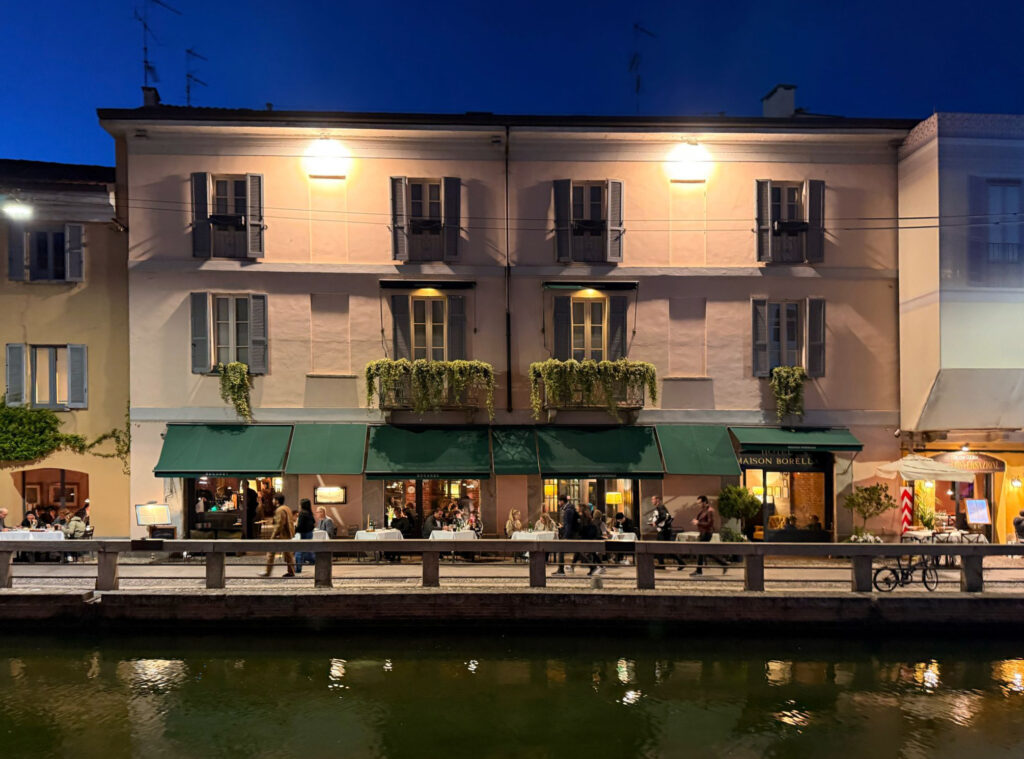
Il ristorante Bugandé (“lavandai” in dialetto) aperto all’interno del Boutique Hotel Maison Borella realizzato riadattando una antica casa di ringhiera. (© Maurizio Carta, 2025).
The Bugandé restaurant (“laundrymen” in dialect) opened inside the Boutique Hotel Maison Borella built by adapting an old railing house. (© Maurizio Carta, 2025).
Ma ogni stagione ha il suo crepuscolo. Il 31 marzo 1979, l’ultimo barcone attraccò alla darsena, segnando la fine del traffico portuale e, con esso, il tramonto della sua storica funzione. Tuttavia, le aree portuali possiedono un’energia latente, una peculiare capacità di trasformarsi, di reinventarsi. Così, ciò che era stato cuore del commercio sull’acqua iniziò a pulsare di nuova vita: taverne, birrerie, ristoranti, locali di musica e spazi creativi presero il posto dei magazzini e delle botteghe attraendo il popolo della notte. Nacque un vero e proprio distretto cultural-gastronomico, un nuovo polo della movida proiettato verso nuove forme di espressione. Con il cambiamento delle funzioni mutarono anche i fruitori della zona che ben presto trasformarono quello che era stato un quartiere portuale in un distretto alla moda. I magazzini e le botteghe del porto, un tempo frequentati dagli operai, dai commercianti ma anche dai contrabbandieri – i cosiddetti “sfrosador”, che cercavano di evitare il dazio facendo entrare in città le merci senza pagare – lasciarono il posto a loft lussuosi, uffici eleganti, appartamenti alla moda e studi professionali frequentati dai turisti, dagli studenti e dalle modelle.
L’inevitabile processo di gentrificazione lentamente ha espulso gli abitanti originari e, con essi, le loro tradizioni e il loro modo di vivere il quartiere. Quasi tutte le osterie hanno chiuso i battenti e, al loro posto, si sono moltiplicati infiniti locali di ristorazione per rispondere ad una nuova domanda di intrattenimento e ristorazione. Affacciati sulla darsena e lungo i canali, sono nati innumerevoli locali che offrono un viaggio culinario senza confini: oltre alla cucina del posto, si possono degustare le specialità delle altre regioni del paese; largo spazio occupa la cucina etnica con ristoranti giapponesi, cinesi, thailandesi e indiani; e ancora, steck house in stile americano, bistrot in stile francese, pizzerie non solo partenopee, wine bar e cocktail bar, birrerie e caffetterie, paninerie, kebab e tanto, tanto street food di ispirazione sudamericana e sud italiana.
But every season has its twilight. On March 31, 1979, the last boat docked at the dock, marking the end of port traffic and, with it, the sunset of its historic role. Yet port areas have a strange kind of magic: a hidden energy and a talent for transformation, for reinvention. Thus, what had been the heart of the water trade began to pulsate with new life: taverns, breweries, restaurants, music venues and creative spaces took the place of warehouses and shops, attracting the people of the night. A true cultural-gastronomic district was born, a new nightlife pole projected towards new forms of expression. As the area’s function changed, so did its people. What had once been a working-class port neighbourhood gradually turned into a fashionable quarter. The warehouses and old shops of the port, once the playground of workers, traders, and even smugglers – the famous “sfrosador”, who tried to avoid duty by letting goods enter the city without paying – gave way to luxurious lofts, sleek offices, trendy apartments, and professional studios, now frequented by tourists, students and models.
Of course, the inevitable tide of gentrification slowly swept away the original inhabitants, along with their traditions and their way of living in the neighbourhood. One by one, the old taverns shuttered their doors. In their place, an endless array of catering establishments bloomed to meet the demands of a new, entertainment-hungry clientele. Today, overlooking the dock and along the canals, a seemingly infinite number of venues offers a world tour on a plate: alongside traditional local dishes, you’ll find flavours from all over — hearty regional specialties, plenty of Japanese, Chinese, Thai, and Indian restaurants, American-style steakhouses, French-style bistros, and pizzerias (not just Neapolitan!). And that’s not all: wine bars, cocktail lounges, breweries, cafés, sandwich shops, kebab stalls, and a whole lot of South American and Southern Italian-inspired street food make the area a paradise for adventurous palates.
Ristoranti e barconi adibiti a locali di intrattenimento in una delle vie d’acqua della città. A sinistra, l’antica Osteria con cucina Posto di conversazione. (© Maurizio Carta, 2025).
Restaurants and barges used as entertainment venues in one of the city’s waterways. On the left, the ancient Osteria with kitchen Locale di Conversazione (Conversation place). (© Maurizio Carta, 2025).
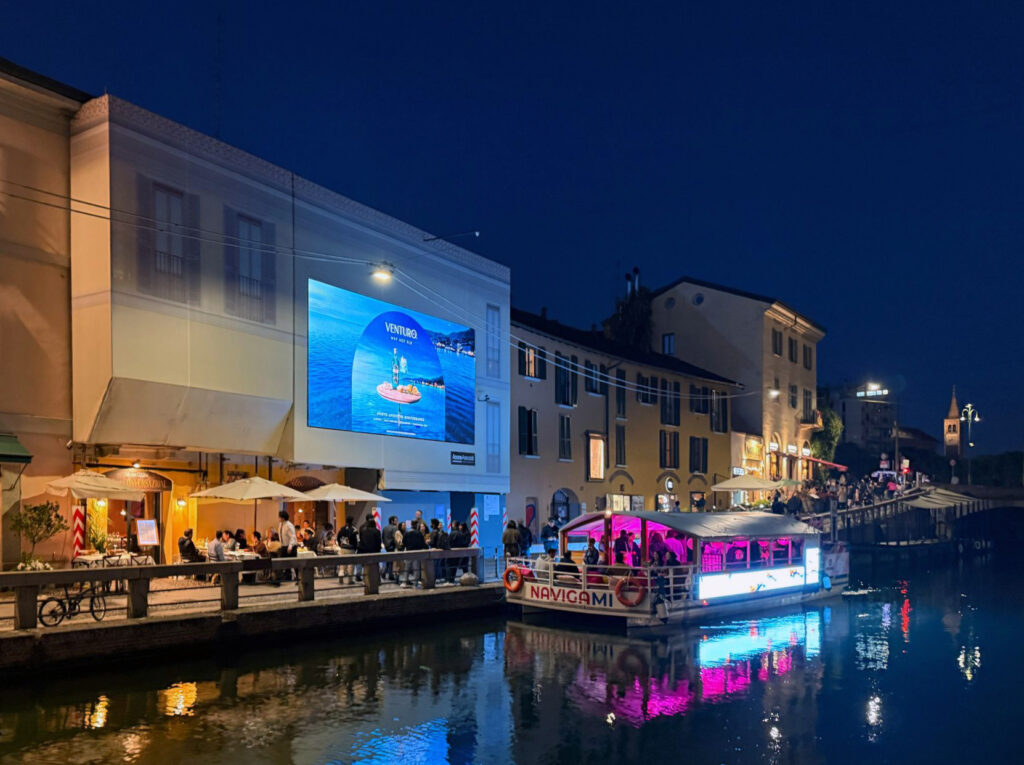
Ristorante galleggiante ricavato trasformando una antica chiatta per il trasporto delle merci sulle acque del canale. (© Maurizio Carta, 2025).
Floating restaurant created by transforming an ancient barge for the transport of goods on the waters of the canal. (© Maurizio Carta, 2025).
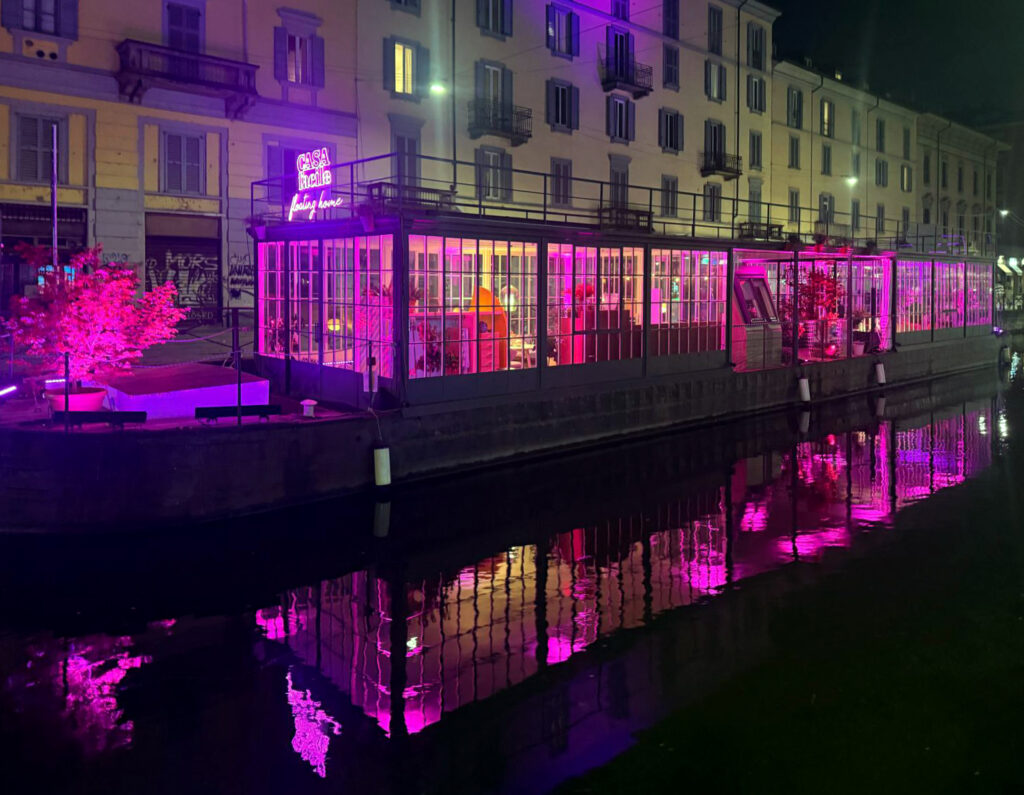
In questa strabordante offerta gastronomica, frammisti ad un’offerta ristorativa globalizzata e omologante, resistono ancora alcuni ristoranti dove trionfa gloriosa la cucina regionale e alcuni locali d’avanguardia, come il bar più piccolo del mondo. Qui, appena quattro metri quadrati possono ospitare un massimo di quattro avventori (su prenotazione, ovviamente), mentre gli altri si devono accontentare di un drink d’asporto.
Amid this overwhelming culinary landscape, — overflowing with a globalized, often homogenized mix of restaurants — a few gems still shine. You can still find spots where glorious regional traditions reign supreme, alongside a handful of avant-garde places, like the world’s tiniest bar. Here, in just four square meters, no more than four lucky guests (with a reservation, naturally) can squeeze in at once — while everyone else has to make do with a drink to-go.
Backdoor43, il bar più piccolo del mondo. (© Maurizio Carta, 2025).
Backdoor43, the smallest bar in the world. (© Maurizio Carta, 2025).
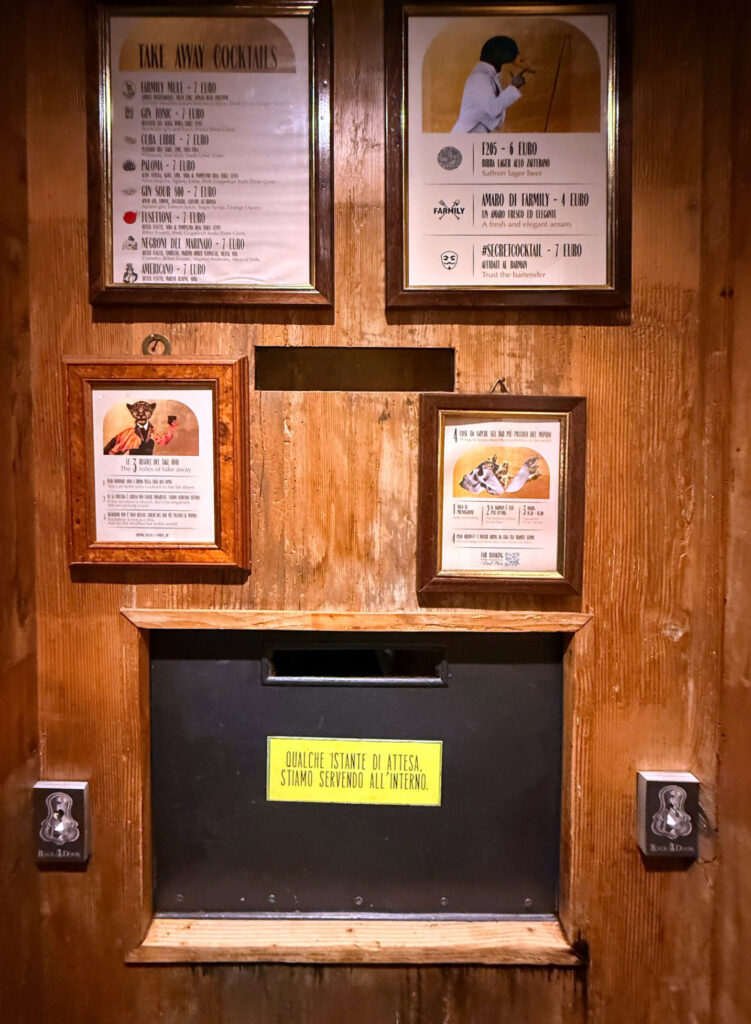
Questa città dimostra ancora una volta la sua straordinaria capacità di rinnovarsi ma con radici ben piantate nell’acqua. Sì, perché questa città non ha mai smesso di “scorrere”. E solo alla fine di questo racconto, immaginandoci con un bicchiere di vino in mano bevuto al tramonto sul riverbero dell’acqua e un paio di mondeghili [7] fritti a dovere in abbondante burro, ci rendiamo conto con stupore che questa città portuale, dalle mille anime e dai mille sapori, non si affaccia sul mare.
È Milano.
Once again, this city proves its extraordinary talent for reinventing itself — all while keeping its roots firmly anchored in the water. Because here, the city has never really stopped flowing. And only at the end of our story, glass of wine in hand, sipping at sunset while the water shimmers and nibbling on a couple of perfectly butter-fried mondeghili [7], do we realize — with a smile of amazement — that this port city, with its thousand souls and a thousand flavours, doesn’t even face the sea.
It’s Milan.
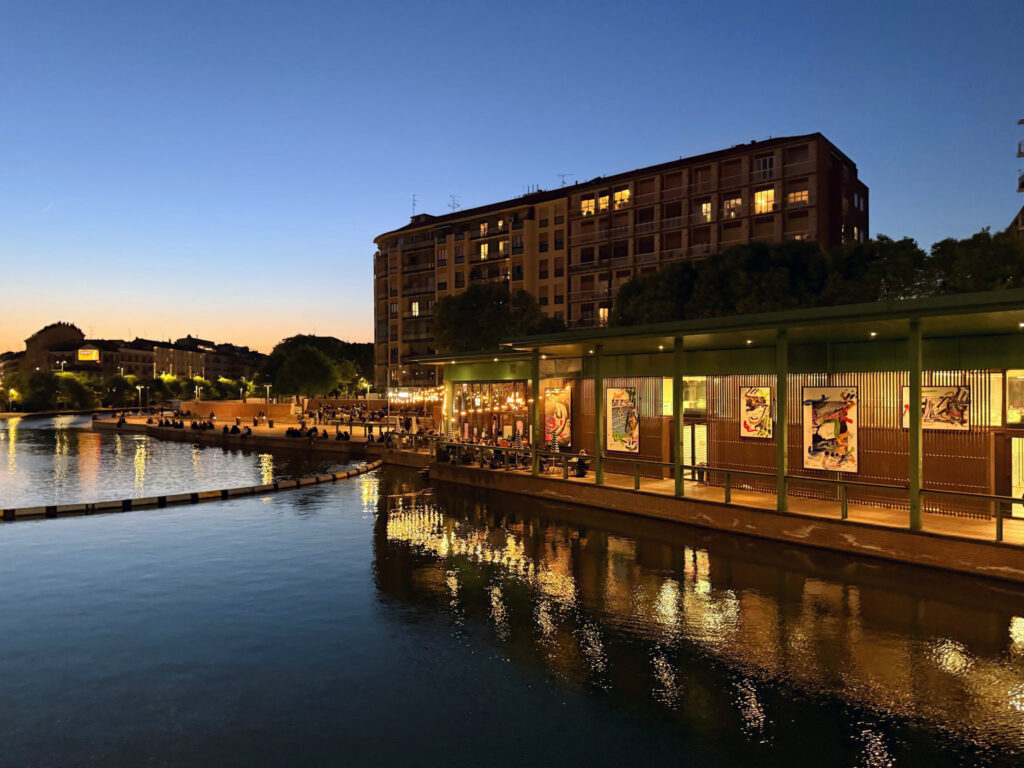
La darsena, un tempo il porto della città, oggi è uno dei luoghi della movida più frequentati della città. (© Maurizio Carta, 2025).
The dock, once the city’s port, is now one of the busiest nightlife venues in the city. (© Maurizio Carta, 2025).
IMMAGINE INIZIALE | Alzaia Naviglio Grande, strada pedonale lungo il canale affollata di locali di ristorazione. (© Maurizio Carta, 2025).
HEAD IMAGE | Alzaia Naviglio Grande, a pedestrian street along the canal crowded with restaurants. (© Maurizio Carta, 2025).
╝
NOTE
NOTES
[1] Casera indica un caseificio con magazzino di stagionatura.
[2] La polenta taragna è una preparazione culinaria i cui ingredienti sono la farina di mais, la farina di grano saraceno, il burro e il formaggio.
[3] La raspadüra indica le sottili sfoglie di formaggio che si ottengono dalla raschiatura della superficie della forma dei formaggi della famiglia dei grana.
[4] Verdura, una varietà di bietola con gambi spessi e foglie grandi.
[5] La cassœula è un piatto invernale preparato con le verze, le parti meno nobili del maiale, inclusa la cotenna, le orecchie, il muso, i piedi e le costine, e il concentrato di pomodoro.
[6] Il pan de mej, o pane di miglio, è un dolce aromatizzato con fiori di sambuco.
[7] I mondeghili sono un piatto di recupero realizzato con gli avanzi del bollito di carne misto a pane raffermo, cipolle, formaggio, prezzemolo, uova e aromatizzato con pepe e noce moscata. Il composto viene suddiviso in piccole polpette fritte nel burro.
[1] Casera indicates a dairy with a maturing warehouse.
[2] Polenta taragna is a culinary preparation whose ingredients are corn flour, buckwheat flour, butter and cheese.
[3] Raspadüra refers to the thin sheets of cheese that are obtained by scraping the surface of the wheel of cheeses of the Grana family.
[4] Vegetable, a variety of chard with thick stems and large leaves.
[5] Cassœula is a winter dish prepared with cabbage, the less noble parts of the pig, including the rind, ears, snout, feet and ribs, and tomato paste.
[6] Pan de mej, or millet bread, is a dessert flavored with elderflower.
[7] Mondeghili are a recovery dish made with the leftovers of boiled meat mixed with stale bread, onions, cheese, parsley, eggs and flavored with pepper and nutmeg. The mixture is divided into small meatballs fried in butter.